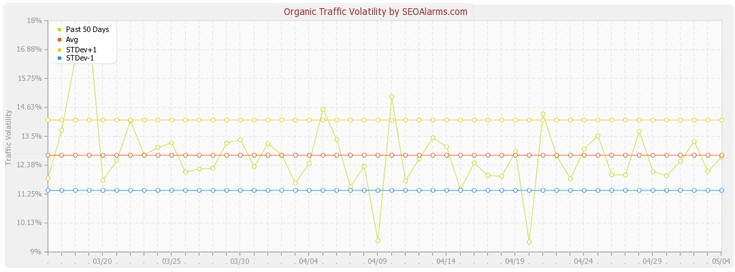Search rankings volatility has become a staple of search metrics. Leaders in the space including MozCast, SERPs Volatility Index, Algoroo, and SERPMetrics Flux all measure flux slightly differently but ultimately look at movement in the search results.
SEOAlarms takes a slightly different approach as well. We aren’t as interested so much is search result fluctuations as we are the impact of those fluctuations on actual search traffic.
Imagine a user searches Google on a Wednesday and clicks the 3rd result. Imagine that same visitors searches Google the very next day for the very same term and clicks the same result. What is the likelihood that user will end up on the same site? Or, more simply, how much does search volatility influence real user behavior?.
Introducing SEOAlarms’s Organic Traffic Volatility. Displayed at all times on the SEOAlarms home page, this volatility measurement looks at 10,000 unique commercial terms daily. Because of this data set, we are less likely to detect volatility in long tail, non commercial keywords. Updates like Hummingbird will be less easily detected.
 If you have any questions, feel free to ask here in the comments. We plan on continuing to improve our organic traffic volatility metric in the future. Oh yeah, did I mention that if you are an SEOAlarms user (free or paid), you will be automatically notified if the volatility jumps above normal levels.JUMP TO A CATEGORY
If you have any questions, feel free to ask here in the comments. We plan on continuing to improve our organic traffic volatility metric in the future. Oh yeah, did I mention that if you are an SEOAlarms user (free or paid), you will be automatically notified if the volatility jumps above normal levels.JUMP TO A CATEGORY
 If you have any questions, feel free to ask here in the comments. We plan on continuing to improve our organic traffic volatility metric in the future. Oh yeah, did I mention that if you are an SEOAlarms user (free or paid), you will be automatically notified if the volatility jumps above normal levels.JUMP TO A CATEGORY
If you have any questions, feel free to ask here in the comments. We plan on continuing to improve our organic traffic volatility metric in the future. Oh yeah, did I mention that if you are an SEOAlarms user (free or paid), you will be automatically notified if the volatility jumps above normal levels.JUMP TO A CATEGORY
WEB ANALYTICS | SEARCH OPTIMIZATION | PAID ADVERTISING | COMPANY NEWS










